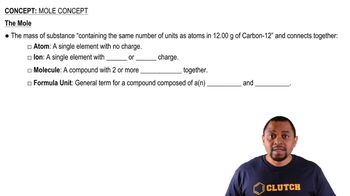Write a ratio showing the relationship between the molar amounts of each element for each compound. (See Appendix IIA for color codes.) (b)

Calculate the empirical formula for each stimulant based on its elemental mass percent composition.
a. nicotine (found in tobacco leaves): C 74.03%, H 8.70%, N 17.27%
b. caffeine (found in coffee beans): C 49.48%, H 5.19%, N 28.85%, O 16.48%
 Verified step by step guidance
Verified step by step guidance
Verified video answer for a similar problem:
Key Concepts
Empirical Formula

Mass Percent Composition

Mole Concept

A chemist decomposes samples of several compounds; the masses of their constituent elements are listed. Calculate the empirical formula for each compound. b. 2.677 g Ba, 3.115 g Br
A chemist decomposes samples of several compounds; the masses of their constituent elements are listed. Calculate the empirical formula for each compound. c. 2.128 g Be, 7.557 g S, 15.107 g O
Calculate the empirical formula for each natural flavor based on its elemental mass percent composition. a. methyl butyrate (component of apple taste and smell): C 58.80%, H 9.87%, O 31.33%
Calculate the empirical formula for each natural flavor based on its elemental mass percent composition. b. vanillin (responsible for the taste and smell of vanilla): C 63.15%, H 5.30%, O 31.55%
The elemental mass percent composition of ibuprofen (a nonsteroidal anti-inflammatory drug [NSAID]) is 75.69% C, 8.80% H, and 15.51% O. Determine the empirical formula of ibuprofen.
